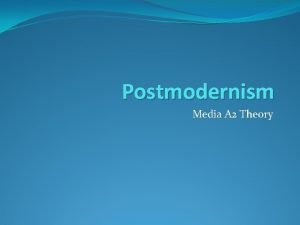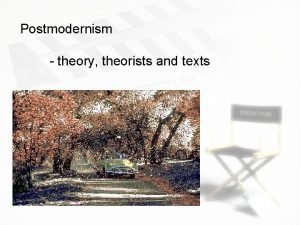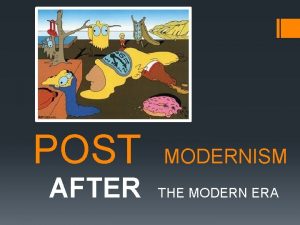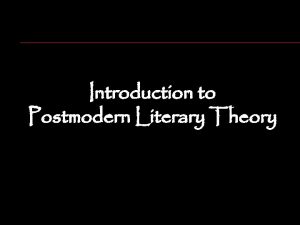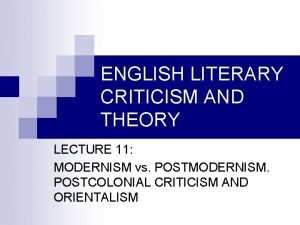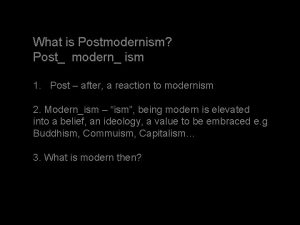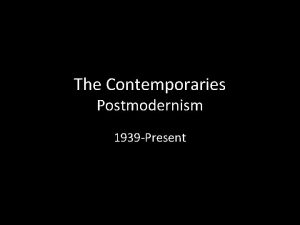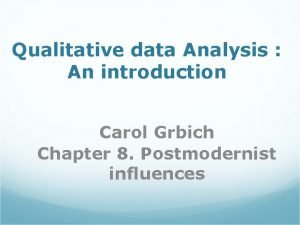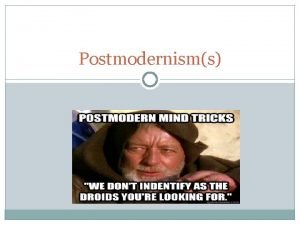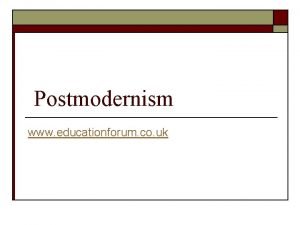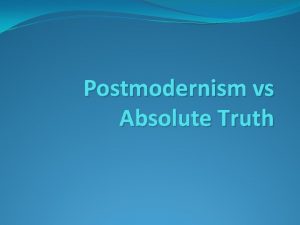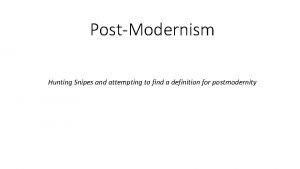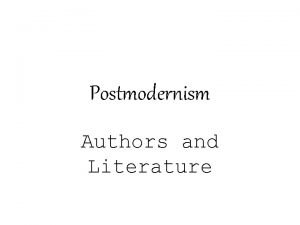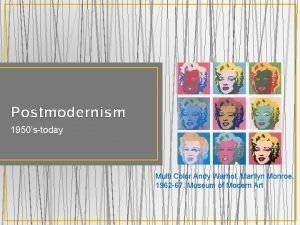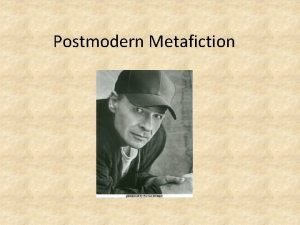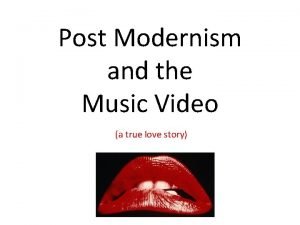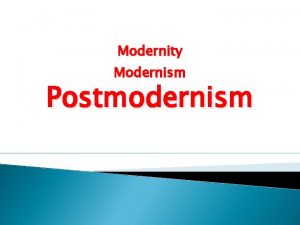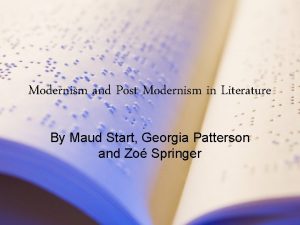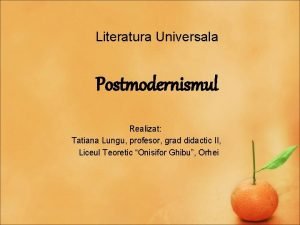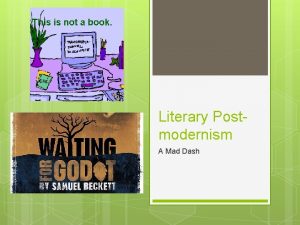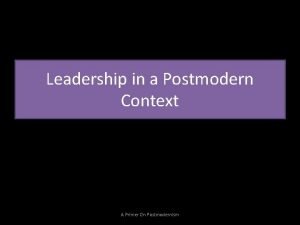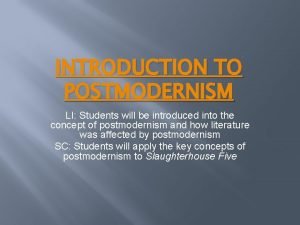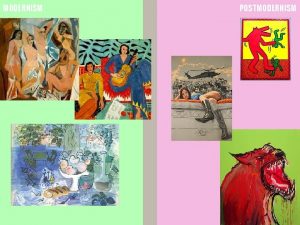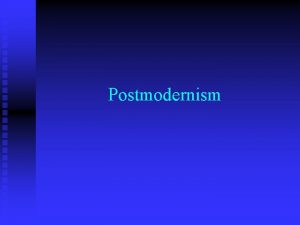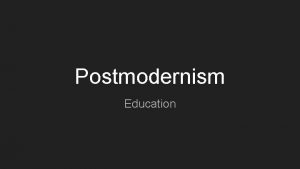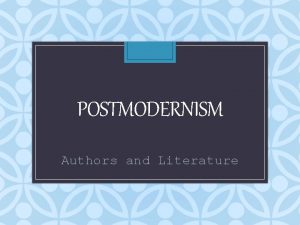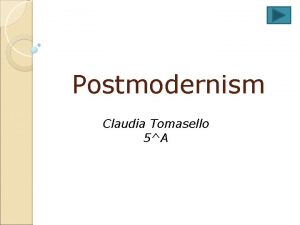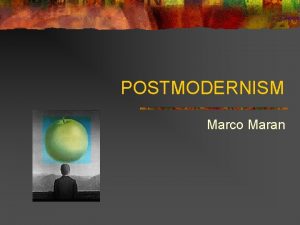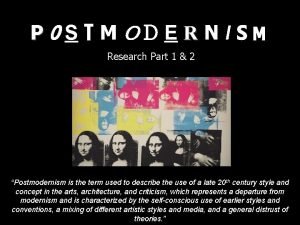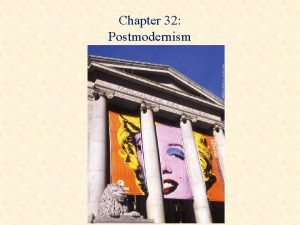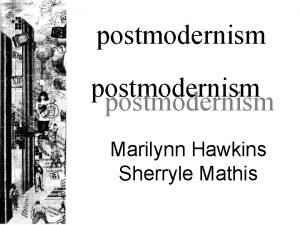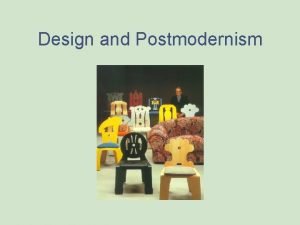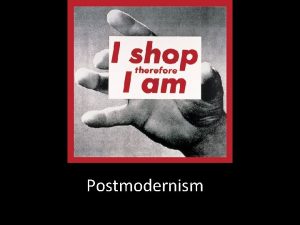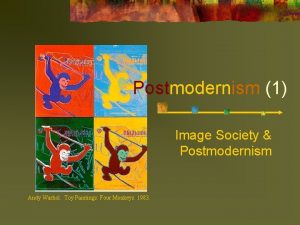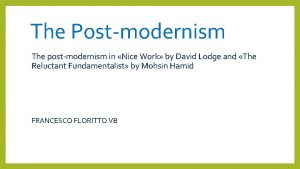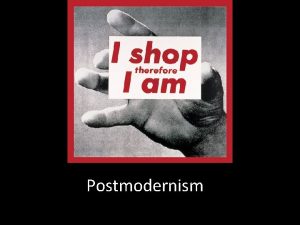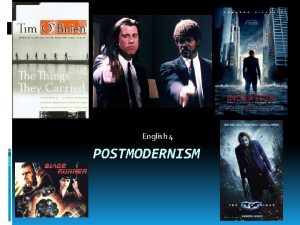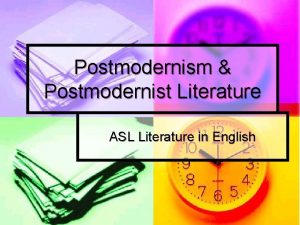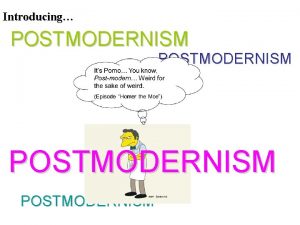Postmodernism Media A 2 Theory Postmodernism A theory

























- Slides: 25

Postmodernism Media A 2 Theory

Postmodernism �A theory that works on a structural and political level �Can help when needing to analyse the fragmentary and contradictory nature of many contemporary media texts. �Useful when thinking about context of production, visual style and inter-relationships between texts.

Postmodernism: What is it? �Firstly , the social, political, cultural values prevalent at the end of C 20 th / early C 21 st �What values / beliefs seem to define this context? �Postmodern context can be defined by some of the following elements: �Decline in political parties and trade unionism. �Collapse of communism and belief in the ability of governments to centrally plan societies. �Insecurity / uncertainty. �Media saturated society / instantaneous communication. �An emphasis on difference rather than uniformity. �Emphasis on the individual, rather than the collective? �Increased emphasis on the importance of style and the visual.

Postmodernism �These elements can be seen as the CONTEXT WITHIN WHICH CONTEMPORARY MEDIA TEXTS ARE PRODUCED. �In a postmodern culture, there is a greater sense of ‘anything goes’ – audiences constructing their own meanings from a range of cultural and media artefacts �How many of the media texts you consume are remakes / reproductions of previous works?

Postmodern Media – Julian Mc. Dougall �Postmodernists claim that in a media-saturated world, where we are constantly immersed in media, 24/7 – and on the move, at work, at home – the distinction between reality and the media representation of it becomes blurred or even entirely invisible to us. In other words, we no longer have any sense of the difference between real things and images of them, or real experiences and simulations of them. �Media reality is the new reality.

Is this an historical development? �Some see this as a historical development: the modern period came before, during which artists experimented with the representation of reality. � The postmodern comes next, where this idea of representation gets ‘remixed’, played around with, through pastiche, parody and intertextual references – where the people that make texts deliberately expose their nature as constructed texts and make no attempt to pretend that they are ‘realist’.

Postmodern ideas. . �Postmodern media rejects the idea that any media product or text is of any greater value than another. �All judgements are merely taste. Anything can be art, anything can deserve to reach an audience, and culture ‘eats itself’ as there is no longer anything new to produce or distribute. �Can anything be ‘art’? What defines ‘art’?

Is this art? • Tracey Emmin • ‘My Bed’ • Exhibited at the Tate Gallery, 1999 • Shortlisted for the Turner Prize

Lyotard: postmodern philosopher �Lyotard suggests that in a post-modern period, over-arching theories and explanations of the word, or metanarratives, ( grand narratives) such as Marxism, capitalism, religion and science have been debunked (stripped away). This has lead to a greater instability in society. �Is this the case, in your view?

BUT… �It can be argued that there is a greater range of religions, interpretations of religions – people can pick a version that suits them! �People have turned to different types of groups to find guidelines on how to live life – gain a sense of certainty – manage an unstable society.

Postmodernism is today's culture � Typical comments are that we now live in a 'three minute culture' because of the typical attention span needed to watch advertising on television. It is also claimed that we are part of an over visual society owing to the preponderance of television. Our reality is dominated by popular media images; culture is no longer viewed as art mirroring life but a reality in itself. Our reality today is littered with video footage, computergames, advertising, film, television images and photographs. � In our media today we have a host of historical documents. Once upon a time a film was a clear linear narrative, once an advert was an earnest attempt to inform you about a product, once a camera could not lie and photography was a failsafe recording document. Today this is far from the truth. In the postmodern era the emphasis is on playing around with these media products. We can: doctor images, chop and change narratives until they are hardly recognisable as linear and advertise products in a fun way.

Dominic Strinati �"Postmodernism tries to come to terms with and understand a media-saturated society. The mass media, for example, were once thought of as holding up a mirror to, and thereby reflecting, a wider social reality. Now that reality is only definable in terms of surface reflection of the mirror" (1992) �"Media images encourage superficiality rather than substance, cynicism rather than belief, the thirst for constant change rather than security of stable traditions, the desires of the moment rather than the truths of history" (1992) �"Postmodernism is sceptical of any absolute, universal and allembracing claim to knowledge and argues that theories or doctrines which make such claims are increasingly open to criticism, contestation and doubt" (1992

Post –modern media texts �In a media saturated world, people can ‘channel hop’, click between internet sites, listen to music etc simultaneously! �This leads to different media products – merging and blending previously clear boundaries of taste, style and genre. . �Characteristics of post-modern media texts:

1. The breakdown of the distinction between culture and society. �Art once reflected reality. Strinati comments that reality now incorporates art in the form of media texts. Today we make sense of reality with reference to media texts. For example, there is a tendency in newspapers to accompany factual articles with film stills. �Our society today is also heavily influenced by media, particularly advertising. Advertising can make or break a company, irrespective of the quality of the product, a poor product can be successful due to great advertising while an excellent product can fail. Where once the reality of the product would create its success or failure, now advertising does this job (hardly real though is it!)

2. An emphasis on style at the expense of substance and content. �Because our reality is becoming more idealised, more media saturated and more consumer led, postmodern texts have little real substance to refer to. People are influenced by branding when buying, the label becomes more important than the product and the packaging more important than the contents, people buy inferior products over superior ones because they like the colour of the packaging… bizarre but true! �In media texts this can manifest itself in intertextuality, where texts make their meaning through references to other texts. 'The Simpsons' is a classic example. Inferior media texts can also do this to try to capture an audience rather than thinking up original ideas of its own.

3. The breakdown of the distinction between high culture (art) and popular culture. �There once was a time when high art was removed from popular culture. Andy Warhole created multi-coloured prints of the Mona Lisa; dance music samples classical music once heralded as genius; advertising regularly raids the image bank to mix old and new. �This mixing is often referred to as bricolage, a French word meaning jumbled. Bricolage refers to the process of adapting and juxtaposing old and new texts, images, ideas or narratives to produce whole new meanings.

4. Confusions over time and space. � In today's society we have accelerated the speed information can travel over distances. Satellites beam down television links from other countries in seconds. The internet can send mail to someone on the other side of the world in hardly any time at all. Strinati believed that: � "because of the speed and scope of modern mass communications, because of the relative ease with which people and information can travel, time and space become less stable and comprehensible, more confused, more incoherent, more disunified. " � Where once it would take days to get to the nearest city we now have access to most of the world in just seconds. The technological age has created a very different time and space reality from the physical reality of travelling to places. even travel is becoming ever faster and cheaper. It seems the whole world is now accessible to us, and, due to the mass media (television and the internet primarily) we have access to the whole world from the comfort of our homes. � Postmodern society is a society built on instataneity, everything is here and now, there is no time to just 'smell the roses'. Maybe, as some critics argue, the speed of our society is causing all the stress.

5. The decline of meta-narratives. �Meta narratives are those which are read by communities and used to understand reality. They can be religious, 'The Bible' or 'The Koran', or they can be political tomes, 'Das Capital'. In the ancient world there were the mythologies that held people together. These meta-narratives bind communities together and create an authority to believe in. The strength of these so called meta narratives is waning. In the postmodern society people are no longer believing there absolute ways to explain reality.

Also… �Playful / ironic �Fragmented �Diversity of representation / viewpoint �Use of pastiche and parody(mocking / caricature)

Baudrillard and hyper-reality �B explores relationship between media and modern world. �Argued that we live in a world of hyper-reality – daily world and world of media are merging and media texts seem more real than the reality they seek to convey. �Media merely represents other media – it is a simulacrum. �Eg. Some films are based on video games Lara Croft: Tomb Raider

Simulacra. . �The simulacra that Baudrillard refers to are signs of culture and media that create the perceived reality; Baudrillard believed that society has become so reliant on simulacra that it has lost contact with the real world on which the simulacra are based. �The original painting is in a museum and most people will not have seen it. �Their experience of the painting is through a reproduction either print or now digital.

Cyberspace and virtual reality �Video games allow participants to move around imaginary 3 D world. �VR used to train pilots etc but in the main used to play games / act out fantasy: �Critics see it in dystopian terms: �Destroys sense of reality �Inhibits brain development �Stifles development of relationships (moral panics? ? ) �Concerns centre on the hyper-reality that these texts create. �Is cyberspace liberating? Dangerous?

Is there an aesthetic style to postmodern texts? To summarise : �the postmodern text blurs the boundaries of high art and popular culture. � it contains Bricolage: creating a media texts out of artefacts, styles, signs from other media texts / cultural artefacts – aspects of one style given a different meaning by blending with another. �it tries to play with narrative constructions and traditions, it blurs the essence of the real with things that are surreal of hyper real (humans and machines for example) � meaning is often lost at the expense of style and technology is increasingly favoured over the more human elements of conventional film making.

Task �The Matrix �Pulp Fiction �Baz Luhrman’s ‘Romeo and Juliet’ �Choose one of the episodes of ‘Brass Eye’. �Consider this as an example of a postmodern text. Discuss which aspects of the text would suggest it could be read as a post modern text.

Post modern media characterised by: A definition of postmodernism Label given to Cultural forms since the 1960 s that display the following qualities: Self reflexivity: this involves the seemingly paradoxical combination of self-consciousness and some sort of historical grounding Irony: Post modernism uses irony as a primary mode of expression, but it also abuses, installs, and subverts conventions and usually negotiates contradictions through irony Boundaries: Post modernism challenges the boundaries between genres, art forms, theory and art, high art and the mass media Constructs: Post modernism is actively involved in examining the constructs society creates including, but not exclusively, the following: Nation: Post modernism examines the construction of nations/nationality and questions such constructions Gender: Post modernism reassesses gender, the construction of gender, and the role of gender in cultural formations Race: Post modernism questions and reassesses constructs of race Sexuality: Post modernism questions and reassesses constructs of sexuality
 Postmodernism media
Postmodernism media Postmodern theory
Postmodern theory Postmodernism media examples
Postmodernism media examples Postmodernism summary
Postmodernism summary Postmodernism theory in literature
Postmodernism theory in literature Postmodernism definition
Postmodernism definition What is postmodernism
What is postmodernism Characteristics of postmodernism
Characteristics of postmodernism Postmodernism research
Postmodernism research Difference between modernism and postmodernism
Difference between modernism and postmodernism Postmodernism
Postmodernism Premodernism modernism and postmodernism
Premodernism modernism and postmodernism Postmodernity
Postmodernity Postmodernism grand narratives
Postmodernism grand narratives Modernism vs postmodernism
Modernism vs postmodernism Postmodernism definition
Postmodernism definition Andy warhol postmodernism art
Andy warhol postmodernism art Metafiction in postmodern literature
Metafiction in postmodern literature Backstreet boys video
Backstreet boys video Modern postmodern timeline
Modern postmodern timeline Postmodernism vs modernism
Postmodernism vs modernism Postmodernismul definitie trasaturi
Postmodernismul definitie trasaturi Fragmentation literature
Fragmentation literature Postmodern leadership style
Postmodern leadership style To combine or paste together multiple elements
To combine or paste together multiple elements Pastiche postmodernism
Pastiche postmodernism
